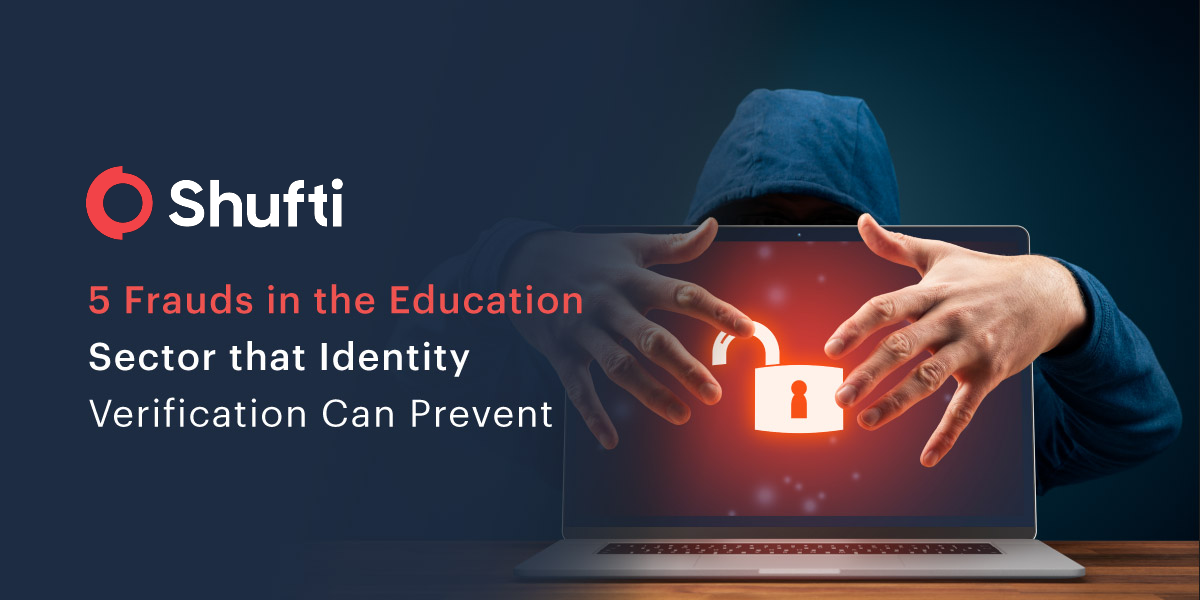2025 Fraud Watch: 5 Growing Threats to Education Providers and How to Beat Them

Education institutions worldwide are under unprecedented attack from increasingly sophisticated fraud rings. Identity theft, deep‑fake documents and bot‑driven “ghost students” are siphoning off millions in financial aid and damaging brand trust. This update combines fresh 2024‑25 data, regulatory moves across the UK, US and EU, and exclusive Shufti analytics to help you tighten controls before the next enrolment cycle.
Why the risk profile spiked in 2025
Over the past 12 months, the attack surface for colleges and universities has widened dramatically. Hybrid learning models, record numbers of data‑breach exposures and the mainstreaming of AI‑enabled forgery tools have converged to create a perfect storm for fraudsters. Economic pressure on students, coupled with larger grant pools and faster digital disbursement rails, means more money is now in play—and organised crime has taken notice.
- Identity fraud dominates. Cifas recorded almost 250,000 identity‑fraud cases in 2024—a 5 % jump on 2023 and 59 % of all fraud filings.[^1]
- Financial‑aid losses are spiralling. California community colleges alone lost US $13 m in Pell Grant and Cal Grant funds last year, a 74 % year‑on‑year surge.[^2]
- Organised networks target tuition loans. Six UK universities saw £7.1 m paid out to fraudulent applicants between 2022‑24.[^3]
Shufti’s 2025 Education Fraud Benchmark shows that 6.4 % of all onboarding sessions across 120+ education clients were flagged as high risk in Q1 2025, with deep‑fake/AI‑generated IDs accounting for 31 % of those alerts (internal analytics).
1. Student‑Loan & Grant Fraud
Fraud rings submit forged documents or impersonate real students to tap generous loan and grant schemes.
New rules to note
| Region | 2024‑25 change | Practical impact |
| United States | The Department of Education resumed fraud flags on 23 Feb 2025 for 2024‑26 FAFSA files, forcing schools to verify high‑risk applicants.[^4] | Expect more ISIRs with Verification‑Tracking flags—plan extra ID checks before disbursement. |
| United Kingdom | The DfE Counter‑Fraud Strategy 2024‑27 prioritises student‑finance integrity and mandates proactive risk assessments.[^5] | Universities must demonstrate robust anti‑fraud programmes during OfS audits. |
Shufti tip: Activate multi‑bureau database screening to catch synthetic IDs before funds are released.
2. Ghost Students & Bot Enrolments
Automated scripts mass‑register “students” in online courses to harvest financial aid or pad enrolment figures.
The San Francisco Chronicle reported bots displaced genuine learners and stole US $13 m in aid across community colleges.[^2]
Defence checklist
- Enforce step‑up liveness checks during registration.
- Rate‑limit bulk applications from identical IP/device fingerprints.
- Cross‑match enrolment data with national learner registries.
3. Admission Document & Credential Forgery
Generative AI has made it trivial to spoof diplomas, transcripts or English‑language certificates.
Red‑flag indicators
- Mismatched fonts/kerning on PDFs.
- Metadata showing non‑institutional authors.
- Credentials issued before the institution’s accreditation date.
Regulatory lens
The EU AI Act (early obligations effective 2 Feb 2025) requires “high‑risk” educational AI systems to undergo rigorous data‑governance audits.[^6] Institutions deploying AI‑assisted admissions must document risk controls or face fines of up to €35 m.
4. Scholarship & Financial‑Aid Phishing
Attackers impersonate bursary offices via email/SMS to harvest credentials and redirect stipend payments.
Data point: The UK Fraud Awareness Report 2024 found 42 % of adults had received a fake scholarship or loan message in the previous 12 months.[^7]
Mitigation
- DMARC enforcement on .edu domains.
- Mandatory secure portals for stipend updates.
- Contextual user‑behaviour analytics.
5. Biometric Spoofing & Deep‑Fake IDs
Fraudsters use silicone masks, 3‑D avatars and video replay to bypass face‑match systems.
Shufti sensors flagged a 230 % year‑on‑year rise in deep‑fake ID attempts across education clients (Q1 2024 → Q1 2025).
Best practice
- Deploy layered PAD (presentation‑attack detection), including texture and micro‑motion analysis.
- Pair biometric checks with proof‑of‑enrolment video interviews.
2025 Compliance & Fraud‑Prevention Roadmap
The timeline below distils emerging statutory deadlines and best‑practice milestones into an actionable project plan. It is designed to help compliance, admissions and IT teams prioritise tasks so that controls are fully operational ahead of audit cycles and peak‑enrolment windows.
| Quarter | Milestone | Action owner |
| Q2 2025 | Map fraud‑risk touchpoints vs. EU/US/UK rules | Compliance & IT |
| Q3 2025 | Roll out Shufti step‑up KYC plus ghost‑student bot detector | Admissions |
| Q4 2025 | Publish first annual fraud‑risk statement under DfE strategy | Finance |
| Q1 2026 | Conduct EU AI Act readiness gap‑analysis | Legal/Compliance |
Conclusion
Education providers can no longer treat fraud as a seasonal nuisance. With regulators tightening rules and fraud rings exploiting AI, proactive controls are essential to protect students, funds and institutional reputation. By combining layered identity verification, bot detection and continuous analytics, institutions can meet 2025 compliance mandates and stay one step ahead of emerging threats.
Frequently Asked Questions
What is the biggest fraud threat facing online programmes in 2025?
Identity fraud coupled with generative-AI document forgery is accelerating fastest, representing 31 % of Shufti high-risk alerts this year.
Do small colleges need the same controls as large universities?
Yes. Attackers automate their campaigns, so any institution offering student finance or issuing visas is a viable target. Controls should scale to enrollment volume rather than campus size.
How long does a Shufti identity check take?
Average verification time across education clients is 30-40 seconds, including real-time liveness and PAD.
Will EU AI Act requirements apply to UK universities?
Indirectly UK schools recruiting EU residents or using EU-developed high-risk AI tools must demonstrate equivalent safeguards.
What ROI can I expect from deploying automated KYC?
Clients report 60 % lower manual-review costs and up to 80 % reduction in fraudulent disbursement cases within the first year.










